Satsuma ware in Meiji era
History
Tea bowl by Yabu Meizan 藪明山, circa 1890 from my gallery
The Satsuma province lies in the Southern part of Kyushu Island. The daimyo (feudal lord) of the province was the prominent Shimazu family. The patronage of this family led to the development of the Satsuma ware.
Satsuma ware 薩摩焼 was firstly produced at Naeshirogawa 苗代川 in Satsuma 薩摩 by skilled Korean potters who were brought by the Prince of Satsuma, Shimazu Yoshihiro 島津義弘, to Kyushu following the invasions of Korea by Japan in 1597.
Fourty-seven Korean people including the leader of potters, Park Ping Yi
朴平意 (Seiemon Okimochi 清右衛門興用), settled and established the first kiln in Naeshirogawa. In 1617, they discovered white pot clay and started to make the white pottery (Shiro-Satsuma), contrasting to the traditional local black pottery (Kuro-Satsuma). Since 1675 their Korean society was officially discriminated by Shimazu Mitsuhisa 島津光久 to keep secret of their pottery techniques, while they were ranked and treated as Goushi 郷士 of Samurai class.
Korean potters began producing vessels for the tea ceremony and other utilitarian purposes. A distinctive aspect of Satsuma earthenware is a cream colored body over which a clear or slightly yellowish glaze is applied, creating a delicate finely crackled network. Early Satsuma pottery was simple and undecorated. In the seventeenth and eighteenth century the production was small and was intended for only the Shimazu clan.
Innovation by Iroe 色絵 techniques learned from Nonomura Ninsei 野々村仁清
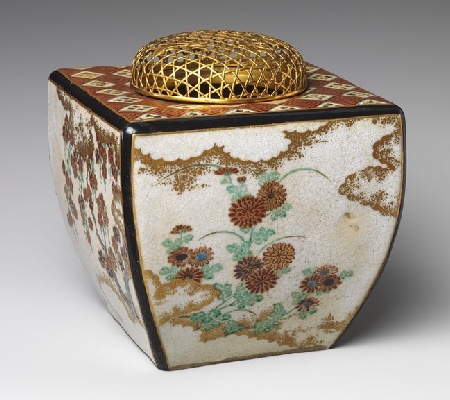 Incense burner (koro), mid-17th century, signed Nonomura Ninsei, Kyoto, Japan.
Source: Nonomura Ninsei: Incense burner (koro) (29.100.668) | Heilbrunn Timeline of Art History | The Metropolitan Museum of ArtDuring the late eighteenth century Satsuma potters from Kagoshima prefecture were sent to Kyoto to learn enamel decoration in response to competition from the highly decorated Imari 伊万里 porcelain wares being produced by their neighbors in the Arita area of Kyushu Island.
Incense burner (koro), mid-17th century, signed Nonomura Ninsei, Kyoto, Japan.
Source: Nonomura Ninsei: Incense burner (koro) (29.100.668) | Heilbrunn Timeline of Art History | The Metropolitan Museum of ArtDuring the late eighteenth century Satsuma potters from Kagoshima prefecture were sent to Kyoto to learn enamel decoration in response to competition from the highly decorated Imari 伊万里 porcelain wares being produced by their neighbors in the Arita area of Kyushu Island.
At Kyoto the potters at the Kiyomizu Kilns 清水窯 were skilled in the art of enamel color decoration on earthenware. During the middle of the seventeenth century Japan's most famous potter, Nonomura Ninsei 野々村 仁清 (active ca. 1646–94), devloped these enamel color decoration techniques and established Nishikite 錦手, applying polychrome overglaze and gold on light fawn clay covered with crackled.
Nonomura Ninsei taught them to his disciples. Hence it was the descendants of Ninsei, working in this style, who taught the technique of applying multicolor enamel and gold decoration to the Satsuma potters.
Upon their return to Kyushu, the Satsuma potters during the last few years of the eighteenth century began to revolutionize their wares with a new range of designs, color, and techniques. In 1647, Satsuma potter Arimura Wannemon 有村碗右エ門 applied newly acquired techniques on Satsuma ware at Reisui Kiln 冷水窯 at Katano竪野 which was establied by Korean potter Kinkai 金海 in Satsuma 薩摩.
In 1793, Hoshiyama Chubei 星山仲兵エ and Kawahara Houkou 川原芳工working at Nagata Kiln 長田窯 at Katano in Satsuma went to Kyoto to laern techniques of Awata Ware 粟田焼 from Kinkozan Sobei III 三代目錦光山宗兵衛.
From the end of the eighteenth century, ceramics with highly detailed painted decoration in thickly applied gold and colors were being fired at the Naeshirogawa kiln 苗代川窯. Typically floral, stylized and geometric patterns were employed. Shishi, dragons and phoenix designs were also frequently depicted. Landscapes and human figures did not appear until the middle of the nineteenth century. The ability to create shades of color was also developed during this period.
Iso Oniwayaki Kiln 磯御庭焼窯 (1855-1927)
In 1855, Lord of Satsuma, Shimazu Nariakira 島津斉彬 (1809-1858), establihshed Iso Oniwayaki Kiln 磯御庭焼窯. He intended to promote Satsuma ware as important export goods. He researched the Western glaze techniques and invented Satsuma ware as a highly decorated and precious tribute to nobles, including the Tokugawa Shogun.
It should be recalled that Satsuma wares were made for the Japanese household and not for export before mid-nineteenth century. They tended to be small and included tea bowls (Chawan), water jars (Mizuzashi), incense burners (Koros), incense boxes (Kogos), and vessels for flower arrangement (Ikebana).
In 1867 the Shimazu family exhibited their wares at the Paris International Exposition. The wares were well accepted, and a substantial export market to the West became established through this exposition.
At the 1873 Vienna International Exposition, the twelfth-generation head of the Chin family, Chin Jukan 沈 寿官 (1835-1906), exhibited large vase that also won accolades.
These two international exposition firmly established the praiseworthy reputation of Satsuma ware.
Kyo-Satsuma 京薩摩
Hundreds of butterflies drawn inside the tea bowl by Yabu Meizan 藪明山, circa 1890 from my galleryThe strong demand for Satsuma wares caused other Japanese potters, particularly those of Kyoto, to produce "Satsuma" earthenware vessels. The Satsuma producers in Kyoto were largely located in the suburb of Awata 粟田. These producers worked in various sized studios and since their activities occurred during the Meiji period they were not sponsored by daimyos. Their pieces were almost exclusively made for export.
A large quantity of poor and mediocre quality Satsuma was produced in the Kyoto area during the Meiji period. However, a small number of extremely fine quality pieces were also produced. Famous potters from the Kyoto area;
- the seventh-generation of Kinkozan Sobei VII 七代目 錦光山 宗兵衛 (1868-1927) whose factory was by far the largest, employing more than 250 potters.
- Seikozan 精巧山
- Ryozan 亮山. Style name Ryozan (real name Nakamura Tatsunosuke) was adopted by him from his teacher and predecessor, the celebrated early 19th century Kyoto potter Nishimura Zengoro. Ryozan is the most famous of the artists working for the Yasuda company. Pieces from the company Yasuda Kyoto Tokiji Goshigaisha usually have the full name of the company plus the trademark. The best known & most regarded of the artists working for this company was Ryozan. Another artist was Seikozan.
- The studio of Yabu Meizan 藪明山 (1853-1934) was located nearby in Osaka.
- At Yokahama, Makuzu Kozan, a studio artist (perhaps most famous for his innovative porcelains) produced an assortment of earthenware objects in Satsuma style.
Makers of Satsuma-style pottery were also located on the Isle of Awaji, Tokyo, Yokahama, Seto, Saga, Kobe and Nagoya.
The 1893 Chicago International Exposition proved to be a major turning point for Satsuma ware, as the first sign of a wane in its popularity became apparent. At the 'fin d'siecle', people desired novelty, and new trends in art such as Art Nouveau were beginning to have an impact on taste.
The fine works exhibited by Kinkozan at the fair were poorly received. Kinkozan Sobei reacted by adopting new designs, styles, and techniques and creating pieces in an Art Nouveau style.
On the other hand, Yabu Meizan chose to forgo innovation in favor of striving to perfect the traditional style he had developed.
In spite of their poor reception at the Chicago International Exposition, the work of both workshops continued to sell well. Though the kilns are no longer in existence there are many avid collectors of both wares around the world.
Seiji Yamauchi
Kinkozan 錦光山 (Ⅵ:1824-1884, Ⅶ:1868-1927)
Awataguchi Ware
 Vase by Kinkozan 錦光山, circa 1900 from my galleryIn the past, there were seven main streets connecting Kyoto and its neighboring cities. The seven connecting points of these streets to Kyoto have been called “Kyo-no-Nanakuchi 京都七口 (seven entrances of Kyoto)”. One of them, “Awataguchi 粟田口” was the final point of Fifty-three stations of the Tokaido 東海道五十三次. Tokaido was the key road connecting Tokyo (Nihon Bashi Bridge 日本橋) and Kyoto (Sanjyo Ohashi Bridge 三条大橋). It still remains as “Awataguchi” at around Sanjo Dori St. where Heian Shrine and Westin Miyako Hotel stand today.
Vase by Kinkozan 錦光山, circa 1900 from my galleryIn the past, there were seven main streets connecting Kyoto and its neighboring cities. The seven connecting points of these streets to Kyoto have been called “Kyo-no-Nanakuchi 京都七口 (seven entrances of Kyoto)”. One of them, “Awataguchi 粟田口” was the final point of Fifty-three stations of the Tokaido 東海道五十三次. Tokaido was the key road connecting Tokyo (Nihon Bashi Bridge 日本橋) and Kyoto (Sanjyo Ohashi Bridge 三条大橋). It still remains as “Awataguchi” at around Sanjo Dori St. where Heian Shrine and Westin Miyako Hotel stand today.
In 1554 Unrinnin Youzou (Tarozaemoni Yasumitsu) 雲林院要蔵 (太郎左衛門尉康光) who came from Omi-koku Shigaraki-gun Kamiyama-mura 近江国信楽郡神山村, established a kiln at Mizorogaike 御菩薩池 and made altarage pottery for Kamo-jinjya shrine加茂神社. His decendants continued to make pottery for generations. Fourth-generation of Unrinnin Asubei 四代雲林院安兵衛 was ordered to make a tea bowl for the Colossal Hall of the Great Buddha by Toyotomi Hideyoshi. In 1645 Seventh-generation of Unrinnin Bunzou 七代雲林院文蔵 moved to establish a kiln at Awataguchi Wakegi-machi 粟田分木町. Eighth-generation of Unrinnin Kyuzaemon 八代雲林院九左衛門 was ordered to make a tea bowl for Tokugawa Shogunate and continued to make tributes tea bowls every year since then. Nineth-generation of Unrinnin Asubei 九代雲林院安兵衛, who also worked for Awata Tenno-sya shrine, was awarded a title "Houzan 寶山" by a buddism priest, Houzan Jinkai 寶山湛海 of Yamato Ikoma-san Houzan-ji temple 大和生駒山寶山寺.
In 1582 First-generation of Yasuda Genzaemoni Munemitsu 安田源左衛門尉宗光, after the defeat in Batttle of Tenmoku-zan, started to make pottery at Seikanji-mura 静閑寺村 in Rakutou 洛東. His decendants continued to make pottery for generations.
In 1624 the first ceramist of Awata, Sanmonjiya Kyuuemon 三文字屋九右衛門, who came from Seto 瀬戸, one of the famous Japanese pottery production area located in current Aichi prefecture, established a kiln in Awataguchi 粟田口 Sanjyo-tori Keage Imamichi-cho 三条通蹴上今道町.
Therefore, early period of Awatayaki glaze is similar to Seto Ware glaze. Also, potteries of Shigaraki Utsushi (Shigaraki style) of earthen ware as well as Kohrai Utsushi (Korean style) were made, according to some historical records.
In 1677 Takahashi Toukurou 高橋藤九郎, who was awarded the title "Taizan 帯山" established a kiln at Awataguchi 粟田口 Higashimati 東町.
Kinkozan
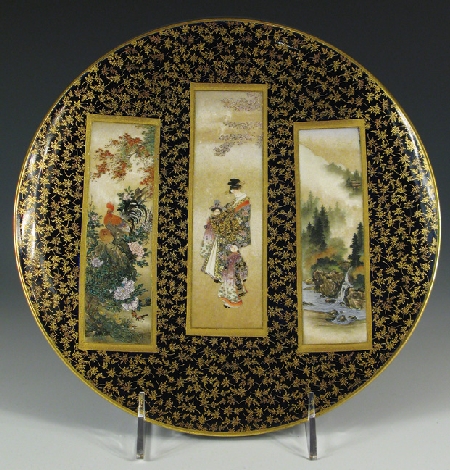 A striking Satsuma plate with a leafy pattern beautifully gilt and positioned on its cobalt surface. The subjects of this artwork, three delicately painted scrolls with exquisite representations of a luxuriously garbed beauty, her baby in arms, of waters rushing along mountainous rockwork and a brilliantly colored cockerel family illustrate the particular genius of this great Kinkozan studio artist. Kinkozan and Sozan signature cartouches on reverse. Diameter, 9.75". Meiji Period.Kinkozan family was a well-known producer of Awata ware 粟田焼 from the mid-Edo period.
A striking Satsuma plate with a leafy pattern beautifully gilt and positioned on its cobalt surface. The subjects of this artwork, three delicately painted scrolls with exquisite representations of a luxuriously garbed beauty, her baby in arms, of waters rushing along mountainous rockwork and a brilliantly colored cockerel family illustrate the particular genius of this great Kinkozan studio artist. Kinkozan and Sozan signature cartouches on reverse. Diameter, 9.75". Meiji Period.Kinkozan family was a well-known producer of Awata ware 粟田焼 from the mid-Edo period.
In 1689, Sixth-generation of Yasuda Gentaro 6代目安田源太郎 (鍵屋) established a kiln at Awata-guchi 粟田口 Nakanomachi 中之町. He was admitted to use the name "Kinkozan 錦光山" from Kuwahara Sanni ?? kyou 桑原三位??卿. His descendants continued to make pottery and use this name "Kinkozan" for more than 200 years.
In 1872, the sixth-generation Kinkozan Sobei 六代目 錦光山 宗兵衛 (1824-1884) and Taizan Yohei 帯山与兵衛, they were very sensitive to the trends of his day, established trade relationships with foreign exporters living in Kobe. He began to incorporate elements of Satsuma ware style into his productions, creating what later came to be known as Kyoto Satsuma ware.
The seventh generation Kinkozan Sobei 七代目 錦光山 宗兵衛 (1868-1927), taking over at the death of his father, followed in his predecessor's footsteps by producing designs of highly detailed and graceful birds-and-flowers compositions. His work won a silver medal at the 1889 Paris World's Fair, when he was only 21 years old. At the time the Kinkozan workshop located at Awata-guchi 粟田口 was the largest in the area, with over 200 artizans.
Numerous other kilns in the Awata-guchi area of Higashiyama were producing Satsuma ware. In addition to Kinkozan, we find many other art signitures, including Seikozan 精巧山, Hankinzan 版錦山, Shizan 司山, Meizan 明山, Kaizan 介山, Sessan 雪山, and Kozan 古山, but little research had been done on which were produced in Kyoto and which were from other locales; generally, only Kinkozan style painted ware is known as Kyoto Satsuma 京薩摩.
 Advatisement.
Advatisement.
Yabu Meizan 藪 明山 (1853-1934)
Maker's mark of Yabu Meizan 藪明山, circa 1890 from my galleryYabu Meizan was born in Nagahori 長堀 of Osaka 大阪 as the second son of the painter Yabu Chosui 藪 長水 (1814-1867). He was a leading craftsman and entrepreneur from Osaka in the Meiji period.
His father, Yabu Chosui, was born at Nantan Hukura 南淡福良 in Awajishima Ireland 淡路島, as a low ranking samurai serving Tokushima domain chief retainer of the Sumoto castle 徳島藩洲本城代家老 Inada Family 稲田家. He was active as a painter in Osaka and known to be a painter drawing a death mask of the famous vangurd of Meiji Restoration, Oshio Heihachiro 大塩平八郎 (1793-1837) whose biological father, Manabe Jiro 真鍋次郎, was also a retainer of the Inada family.
Yabu Meizan studied painting techniques on pottery in Tokyo for six months in 1880, then he returned to Osaka and opened a Satsuma style painted pottery workshop 陶器描画場 at Nakanoshima 中之島 where he produced unique works characterized by highly detailed landscapes and decorative motifs.
 Business Card of Yabu Meizan 藪明山At Yabu Meizan studio, they did not internally fire bisques. Instead, they purchased already-made unglazed pottery from kilns in Kagoshima (Chin Jyukan kiln 沈 寿官) or Kyoto (Kinkozan kiln 錦光山), and concentrated on overglaze process alone.
Business Card of Yabu Meizan 藪明山At Yabu Meizan studio, they did not internally fire bisques. Instead, they purchased already-made unglazed pottery from kilns in Kagoshima (Chin Jyukan kiln 沈 寿官) or Kyoto (Kinkozan kiln 錦光山), and concentrated on overglaze process alone.
His works were awarded in the 14th Kyoto exhibition in 1885 for the first time and after then he started to export his works to the overseas markets.
His works were awarded in the Exposition Universell, Paris in 1889 and 1900, and Louisiana Purchase Exposition in 1904, which steadily established extremely high reputation for his consistently fine, highly decorative and detailed works both at home and abroad. They were called 'Meizan Satsuma' as a brand.
Aside from producing porcelain, Yabu Meizan held socially important positions. He successively served as a director of World's Columbian Exposition Osaka exhibition association, a judge of the Japan Art Association of Osaka Art Exhibition, the display chairman of the 5th National Industrial Exposition, the manager of Louisiana Purchase Exposition Osaka exhibition alliance meeting, etc. He contributed to the development of the craft world of the prewar era, and he was commended from the Osaka prefecture in 1920.
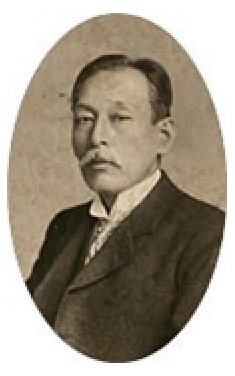 Yabu Meizan 藪明山 (1853-1934)Yabu Meizan came to be recognized as one of the notable craftsmen representing Osaka of the prewar time both in name and in reality. Nonetheless, he could not go against the current of the time. As if keeping step with the state of the world, which was advancing on the path to war, production at his studio was coming to its end after the Japan-British Exhibition held in London in 1910.
Yabu Meizan 藪明山 (1853-1934)Yabu Meizan came to be recognized as one of the notable craftsmen representing Osaka of the prewar time both in name and in reality. Nonetheless, he could not go against the current of the time. As if keeping step with the state of the world, which was advancing on the path to war, production at his studio was coming to its end after the Japan-British Exhibition held in London in 1910.
Several world events such as The World War I (1914-1918) lead a decline in demand for Satsuma porcelain in the Western countries. Switching his arena from overseas, Yabu Meizan showed his work in domestic exhibitions several times before he died in 1934.
Seiji Yamauchi
Seikozan 精巧山
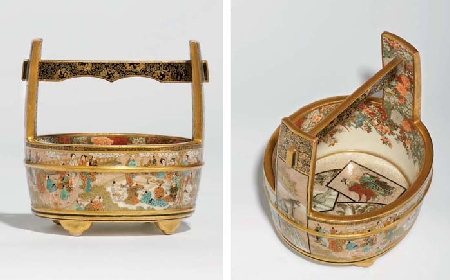 FOUR FLOWER VASES THE FIRST SIGNED SEIKOZAN, MEIJI PERIOD (LATE 19TH CENTURY)
FOUR FLOWER VASES THE FIRST SIGNED SEIKOZAN, MEIJI PERIOD (LATE 19TH CENTURY)
Each decorated in various coloured enamels and gilt, the first with finely detailed scenes of a courtier travelling in a palanquin, blossom viewing, an ape and an eagle beneath pine on a dark blue ground; the second with scholars and attendants; the third with rakkan and samurai and another with scenes from Genji Monogatari
11cm., 15cm., 30cm., 17cm. high
This was sold at $ 9,750 at Christie's zurich on 19 February 2007.
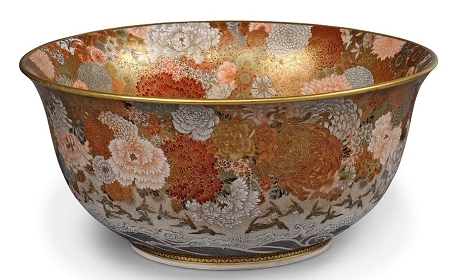 A SATSUMA BOWL
A SATSUMA BOWL
SIGNED SEIKOZAN, MEIJI PERIOD (LATE 19TH CENTURY)
Decorated in various coloured enamels and gilt with chrysanthemums above a band of chidori over waves, the interior with a mass of chrysanthemum and peony flowers
12 5/8 in. (32 cm.) diam.
Provenance: Sold Sotheby's, Olympia, 11 November 2003, lot 124.
This was auctioned at Christie's London on 4 November 2010. Realized price was £6,875 (Estimated price is £3,000 - £5,000).
Ryozan 亮山 (1868-1912)
 Vase signed KYOTO RYOZAN with shimazu mon, late 19th century. Decorated in various enamels and gilt with six panels in relief depicting various street scenes including yari sellers and flowers and foliage, the moulded rim with bamboo in gilt 25.8cm high. This was sold for $ 12,700 at Christie's Zurich on 19 February 2007.Style name Ryozan 亮山 (real name Nakamura Tatsunosuke) was adopted by him from his teacher and predecessor, the celebrated early 19th century Kyoto potter Nishimura Zengoro.
Vase signed KYOTO RYOZAN with shimazu mon, late 19th century. Decorated in various enamels and gilt with six panels in relief depicting various street scenes including yari sellers and flowers and foliage, the moulded rim with bamboo in gilt 25.8cm high. This was sold for $ 12,700 at Christie's Zurich on 19 February 2007.Style name Ryozan 亮山 (real name Nakamura Tatsunosuke) was adopted by him from his teacher and predecessor, the celebrated early 19th century Kyoto potter Nishimura Zengoro.
Ryozan is the most famous of the artists working for the Yasuda company. Pieces from the company Yasuda Kyoto Tokiji Goshigaisha usually have the full name of the company plus the trademark. The best known & most regarded of the artists working for this company was Ryozan. Another artist was Seikozan 精巧山.
 Top
Top Site Map
Site Map References
References About Me
About Me